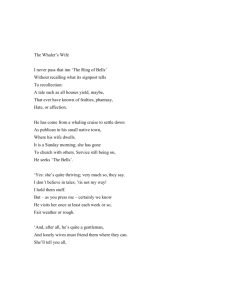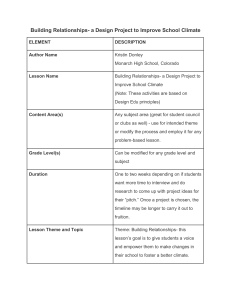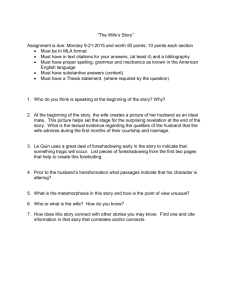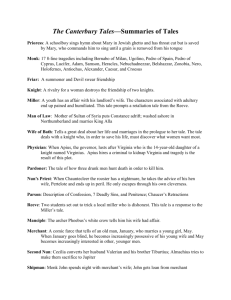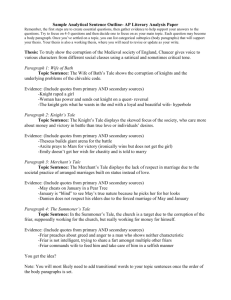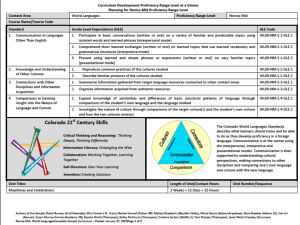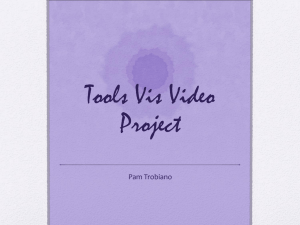11-30-15_12-11-15_The Wife of Bath_s Introduction
advertisement
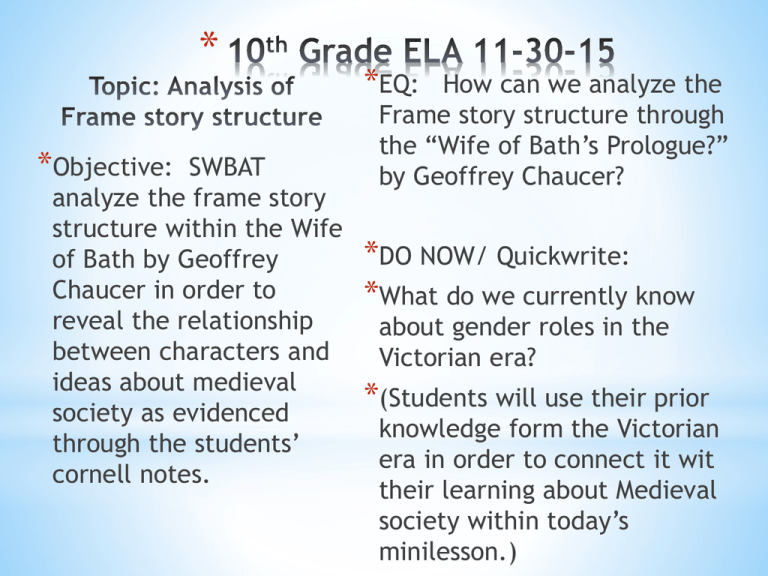
* *Objective: SWBAT analyze the frame story structure within the Wife of Bath by Geoffrey Chaucer in order to reveal the relationship between characters and ideas about medieval society as evidenced through the students’ cornell notes. *EQ: How can we analyze the Frame story structure through the “Wife of Bath’s Prologue?” by Geoffrey Chaucer? *DO NOW/ Quickwrite: *What do we currently know about gender roles in the Victorian era? *(Students will use their prior knowledge form the Victorian era in order to connect it wit their learning about Medieval society within today’s minilesson.) * *Objective: SWBAT analyze the frame story structure within the Wife of Bath by Geoffrey Chaucer in order to reveal the relationship between characters and ideas about medieval society as evidenced through the students’ cornell notes. *EQ: How can we analyze the Frame story structure through the “Wife of Bath’s Prologue?” by Geoffrey Chaucer? *DO NOW/ Quickwrite: *What do we currently know about gender roles in the Victorian era? *(Students will use their prior knowledge form the Victorian era in order to connect it wit their learning about Medieval society within today’s minilesson.) * *Objective: SWBAT analyze the frame story structure within the Wife of Bath by Geoffrey Chaucer in order to reveal the relationship between characters and ideas about medieval society as evidenced through the students’ cornell notes. *EQ: How can we continue to analyze the Frame story structure through the “Wife of Bath’s Prologue” by Geoffrey Chaucer? *DO NOW/ Quickwrite: *-Who is the narrator of the story and how do you know this? GEOFFREY CHAUCER The Canterbury Tales WRITING STYLES Often called the father of English poetry Most scholars still wrote in Latin Felt English lacked sophistication and had a limited vocabulary Only local stories and ballads written in English He wrote in the vernacular or language of the commoners Now known as Middle English Allegory: A story win which the character, settings, and events stand for abstract or moral concepts. It has a literal meaning and a symbolic meaning. Popular in the Middle Ages. Satire: witty language used to convey insult Rhythmic pattern Lack of alliteration Best known for writing The Canterbury Tales, but also had several other works as well THE CANTERBURY TALES Although the work was never completed, The Canterbury Tales is considered one of the greatest works in the English language The narrator meets 29 pilgrims at an inn and travels with them to the shrine of St. Thomas Becket in Canterbury. They decide to have a contest: whoever can tell the best tale wins a dinner at the inn when they get back, courtesy of the other travelers. o Canterbury Tales can be considered “estates satire” o Three “Estates” in European feudal society – Peasants work (agricultural labor) – Clergy pray – Nobles fight (and rule) Begun: 1386 Planned: 120 tales Completed: 22 and 2 fragments * *Mini lesson: We will read the *Objective: SWBAT analyze the frame story structure within the Wife of Bath by Geoffrey Chaucer in order to reveal the relationship between characters and ideas about medieval society as evidenced through the students’ cornell notes. first two pages of the Wife of Bath, in which you will receive insight about the relationship between the Wife of Bath and the Friar, as well as the frame story structure. *Mini lesson: *1) Frame story structure: It is when the pilgrims converse with each other between the different tales. For example, the telling of multiple plotlines within one overarching story. *-Idiom: A fixed expression that has either a literal or a figurative meaning. *Examples: Idioms such as “good as dead” in line 66 and the king decides that the knight must die for his crime in lines 63-67, and the law says that the decision must be carried out. Readers can infer that the phrase means the knight is certain to die. * *-The WIFE OF BATH is the narrator of the story. * Guided Practice: Write down lines within your cornell notes which indicate the relationship between the Wife and the Friar. * Topic: Analyze Story Elements: Narrator * Objective: SWBAT make inferences about the Wife’s character from the kinds of details that she includes within her tale as evidenced from citing the text within their cornell notes. * •RL.9-10.1 * •RL.9-10.2 * •RL.9-10.4 EQ: How can we make specific inferences about the Wife’s character based on the details that she includes within her tale? *QUICKWRITE: What is the punishment that the knight receives and explain why that is the consequence of his action? * Topic: Analyze Story Elements: Narrator * Objective: SWBAT make inferences about the Wife’s character from the kinds of details that she includes within her tale as evidenced from citing the text within their cornell notes. * •RL.9-10.1 * •RL.9-10.2 * •RL.9-10.4 EQ: How can we make specific inferences about the Wife’s character based on the details that she includes within her tale? *QUICKWRITE: *How would you describe the Wife of Bath? What makes her an interesting storyteller? * *Independent work: *-In your cornell notes, write down this question: *What inferences can you make about the Wife’s style of storytelling based off of the way in which she speaks? * *Independent work: *-(Some anticipatory answers include that her style is straightforward and to the point because she states that the knight came plainly and without embarrassment. She is self-assured and does not try to make herself pleasing or inoffensive to others) * 12-04-15 *Guided Practice: *How can you summarize the knight’s experience as he travels the land asking people what women want the most. What does this part of the tale tell you about the Wife of Bath herself? *Answer to question: *-(This part of the story shows that the Wife herself has traveled very far and has met many people around the world, so she has an idea of what they want. Readers can infer that she knows the answer to the Queen’s question and will eventually reveal it through her tale.) *Independent work: *-In the your graphic organizers, write down specific evidence describing how you know that the Wife is an educated woman and whether the Wife’s traits as revealed in the passage make her a likable character. * *Topic: Analysis of Frame story structure *EQ: How can we continue to analyze the Frame story structure through the “Wife of Bath’s Prologue?” by Geoffrey Chaucer? *DO NOW/ Quickwrite: *What do you believe is the answer the knight believes that all women want? Do you agree or disagree with the answer? *Write question in the questions section: *How can you define the frame story structure? *Answer: *Frame story structure is when the pilgrims converse with each other between the different tales. For example, the telling of multiple plotlines within one overarching story. *interpret the following lines *Guided Practice question: which are found in the Wife’s prologue. *The Wife of Bath is described as knowing “the remedies for love’s mischances,/ An art in which she knew the oldest dances.” *What does this line suggest about the Wife’s tale and how does it relate to what line 79 is saying? *-The Wife of Bath is *Guided Practice described as knowing “the QUESTION ANSWER: remedies for love’s mischances,/ An art in which she knew the oldest dances.” The tale will discuss the relationships between men and women, she will share what she knows about love through the events of her tale.) * *EQ: *Topic: Analyze Story Elements: Narrator *Objective: SWBAT make inferences about the Wife’s character from the kinds of details that she includes within her tale as evidenced from citing the text within their cornell notes. How can we make specific inferences about the Wife’s character based on the details that she includes within her tale? *DO NOW/ Quickwrite: *Quick SBL quiz on vocabulary words which were given to students on 11-30-15. *-Student must give a definition and example of the words such as preamble, framestory structure, and idiom. * *Independent work: *-In your graphic organizers, Independent work: you will write down specific evidence describing how you know that the Wife is an educated woman and whether the Wife’s traits as revealed in the passage make her a likable character. * *Independent work: *Some lines to look at include: Independent work: *1) *2) *3) * *EQ: *Topic: Analyze Story Elements: Narrator *Objective: SWBAT make inferences about the Wife’s character from the kinds of details that she includes within her tale as evidenced from citing the text within their cornell notes. How can we continue to make specific inferences about the Wife’s character based on the details that she includes within her tale? * DO NOW/ Quickwrite: *Please look at lines 163-175 and analyze what the forest symbolizes in literature? * *EQ: *Topic: Analyze Story Elements: Narrator *Objective: SWBAT make inferences about the Wife’s character from the kinds of details that she includes within her tale as evidenced from citing the text within their cornell notes. How can we continue to make specific inferences about the Wife’s character based on the details that she includes within her tale? * DO NOW/ Quickwrite Answer: *The forest often represents a place untouched by civilization, the home of spirits or other untamed forces of nature. * *Independent Practice: *Topic: Analyze Story Elements: Foreshadowing *Please write 3 to 5 sentences on the following question: *Objective: SWBAT analyze the literary technique of foreshadowing and how it reflects the visual of the story from the kinds of details that she includes within her tale as evidenced from citing the text within their cornell notes. *What do you predict about the scene with the knight based on the lines of 163175? * *Independent Practice: *Topic: Analyze Story Elements: Narrator *Objective: SWBAT make inferences about the Wife’s character from the kinds of details that she includes within her tale as evidenced from citing the text within their cornell notes. -Please write 3 to 5 sentences on the following question: *What do you predict about the scene with the knight based on the lines of 163-175? *Answer: -Students may state that the wife’s tale will contain mystical elements, perhaps even an event that cannot be explained logically. * *Independent Practice: *Topic: Analyze Story Elements: Narrator *Objective: SWBAT make inferences about the Wife’s character from the kinds of details that she includes within her tale as evidenced from citing the text within their cornell notes. -Please write 3 to 5 sentences on the following question: *What do you predict about the scene with the knight based on the lines of 163-175? *Answer: -Students may state that the wife’s tale will contain mystical elements, perhaps even an event that cannot be explained logically. 12-10-15 Topic: Analyze Story Elements: Foreshadowing EQ: How can we continue to make specific inferences about the Wife’s Objective: SWBAT analyze character based on the the literary technique of foreshadowing and how it details that she includes reflects the visual of the within her tale? story from the kinds of details that she includes within her tale as evidenced from citing the text within their cornell notes. • CCSS.ELALiteracy.CCRA.R.1 • CCSS.ELALiteracy.CCRA.R.3 • CCSS.ELALiteracy.CCRA.R.5 DO NOW: Quickwrite: The Wife of Bath has had five husbands. In the General Prologue, her description indicates that although the Wife is no longer young, she still considers herself to be marriage material. Why do you think the Wife still considers herself to be marriage material? 12-10-15 Topic: Analyze Story Elements: Foreshadowing Foreshadowing: Foreshadowing is a literary device that gives clues to what Objective: SWBAT analyze might happen later in the plot. the literary technique of foreshadowing and how it reflects the visual of the story from the kinds of details that she includes within her tale as evidenced from citing the text within their cornell notes. • CCSS.ELALiteracy.CCRA.R.1 • CCSS.ELALiteracy.CCRA.R.3 • CCSS.ELALiteracy.CCRA.R.5 -The Wife uses foreshadowing to really move her tale forward. For example, “The old woman forces the knight to make a promise that she will hold him to later in the tale.) –I will then ask the students, what is the effect of this foreshadowing on readers? 12-10-15 Topic: Analyze Story Elements: Foreshadowing Guided Practice: You will respond with your answer to the question posed in the minilesson. Objective: SWBAT analyze the literary technique of foreshadowing and how it reflects the visual of the story from the kinds of details that she includes within her tale as evidenced from citing the text within their cornell notes. • CCSS.ELALiteracy.CCRA.R.1 • CCSS.ELALiteracy.CCRA.R.3 • CCSS.ELALiteracy.CCRA.R.5 -Answer: Foreshadowing builds suspense; readers want to continue reading to find out what the old woman will exact from the knight. 12-10-15 Topic: Analyze Story Elements: Foreshadowing Independent Practice: You will review lines 163-231 for the answer Objective: SWBAT analyze the literary technique of to this questions such foreshadowing and how it reflects the visual of the as noting specific story from the kinds of details that will help details that she includes the you visualize this within her tale as evidenced from citing the scene. Please write 3 text within their cornell notes. to five sentence son • CCSS.ELAthe following question: Literacy.CCRA.R.1 Do you believe that the • CCSS.ELALiteracy.CCRA.R.3 Wife’s tale would be a • CCSS.ELAgood movie? Literacy.CCRA.R.5 12-10-15 Topic: Analyze Story Elements: Foreshadowing Objective: SWBAT analyze the literary technique of foreshadowing and how it reflects the visual of the story from the kinds of details that she includes within her tale as evidenced from citing the text within their cornell notes. • CCSS.ELALiteracy.CCRA.R.1 • CCSS.ELALiteracy.CCRA.R.3 • CCSS.ELALiteracy.CCRA.R.5 Possible independent practice answer: -Some answers that the students may say are that it is a faced pace, dramatic narrative, camera action in filming the scenes, such as a wide shot or zoon in, and outlining the key movements of the scenes. 12-11-15 Objective: SWBAT analyze how the Knight’s character has changed throughout EQ: How can we analyze the the text and that change change in the knight’s character reflects the theme of the text as evidenced through and how it reflects the theme of their compare and contrastthe text? t-chart on the knight’s change in behavior. • CCSS.ELALiteracy.CCRA.R.1 • CCSS.ELALiteracy.CCRA.R.3 • CCSS.ELALiteracy.CCRA.R.5 Topic: Analyze Story Elements: Theme DO NOW/ Quickwrite: What kind of answer did the knight give the Queen about what women want? Do you believe his answer stills holds true in our day and age? 12-11-15 Mini lesson: Objective: SWBAT analyze -Theme: how the Knight’s character has changed throughout Chaucer uses the individual tales the text and that change reflects the theme of the to convey ideas about life and the text as evidenced through human condition. their compare and contrastt-chart on the knight’s -The behavior of the characters is change in behavior. • CCSS.ELALiteracy.CCRA.R.1 • CCSS.ELALiteracy.CCRA.R.3 • CCSS.ELALiteracy.CCRA.R.5 often used to communicate themes about human nature. This is particularly true when a character undergoes a major change. 12-11-15 Mini lesson: Objective: SWBAT analyze -Theme: how the Knight’s character has changed throughout We will reread lines 179-187, the text and that change reflects the theme of the looking at the way in which the text as evidenced through knight responds to the old their compare and contrastwoman. Then I will have students t-chart on the knight’s read lines 220-245, looking for a change in behavior. • CCSS.ELALiteracy.CCRA.R.1 • CCSS.ELALiteracy.CCRA.R.3 • CCSS.ELALiteracy.CCRA.R.5 change in the knight’s attitude toward the old woman. 12-11-15 Objective: SWBAT analyze how the Knight’s character has changed throughout the text and that change reflects the theme of the text as evidenced through their compare and contrast t-chart on the knight’s change in behavior. • CCSS.ELALiteracy.CCRA.R.1 • CCSS.ELALiteracy.CCRA.R.3 • CCSS.ELALiteracy.CCRA.R.5 Independent work: -You will describe the contrast between the knight’s attitude towards the old woman earlier in the tale (lines 179-187) and his attitude now (lines 220-245).
